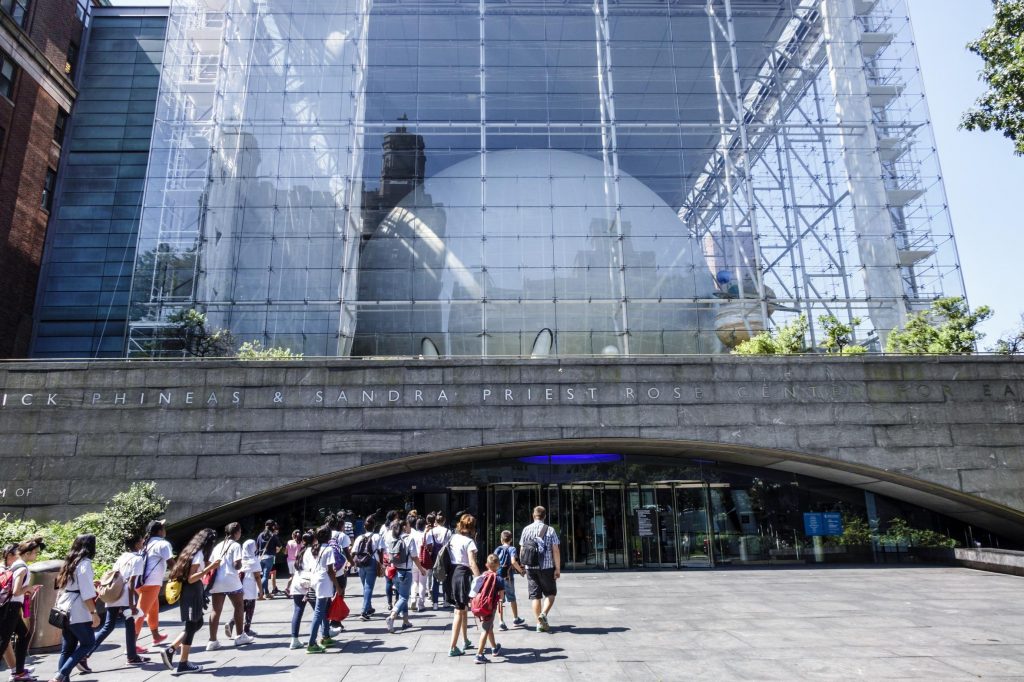The American Museum of Natural History’s new Hayden Planetarium Space show, Encounters in the Milky Way, Illuminates the cosmic movements that shape our galactic neighborhood and place in the universe.
Narrated by Pedro Pascal, Encounters in the Milky Way is being offered during the 25th anniversary of the New York City-based museum’s Frederick Phineas and Sandra Priest Rose Center for Earth and Space.
The museum said, “Our lives are measured in movement: Earth spins on its axis giving us day and night. Seasons change, and years pass, as we travel around the Sun. While the stars in our night sky appear fixed, the constellations unchanging, they are all in motion. Our own star, the Sun, is part of this galactic migration, and it’s taking us along for the ride. Encounters in the Milky Way, the Hayden Planetarium’s seventh space show, is the first to focus on the story of this cosmic motion and how it impacts our solar system.
“Reaching billions of years into the past and peering millions of years into the future, the show’s time-traveling journey is made possible by data from one of the most transformative astronomical projects of the past century: the European Space Agency’s Gaia mission, which launched in 2013 and concluded its mission in March 2025. Gaia has been dubbed the “billion-star survey” for mapping the precise positions, distances, and motions of nearly 2 billion stars in the Milky Way. Using this three-dimensional map, scientists can simulate the dynamics of our entire galaxy and reveal the journey of our own solar system.”
“We’re thrilled to celebrate the Rose Center’s 25th anniversary with the premiere of Encounters in the Milky Way, the latest in a succession of dazzling and eye-opening Hayden Planetarium Space Shows,” said Museum President Sean M. Decatur. “We’re lucky to be living in a golden age of space science and exploration, when new tools and technologies are fueling discoveries and new knowledge about the cosmos. Encounters in the Milky Way combines observations from the Gaia Space Observatory with the latest science visualization capabilities, along with newly upgraded sound technology in our Hayden Planetarium Space Theater, to take visitors on a thrilling journey to experience our galaxy, its history and future, and the dynamic changes continually underway. We can’t wait to share it with our visitors.”
Encounters in the Milky Way was developed by astronomers, educators, science visualization experts and artists, and was produced with collaborators from over 20 academic institutions, including the University of Surrey, NASA’s Space Telescope Science Institute, Southwest Research Institute, the Center for Astrophysics/Harvard & Smithsonian, Technische Universität Berlin, Institute of Science and Technology Austria, and the European Space Agency.
The museum also said that for the first time in the history of the Hayden Planetarium space shows, “a discovery was made during the production process. While fine-tuning a simulation of the Oort cloud, a vast expanse of icy material left over from the birth of our Sun, the Encounters in the Milky Way production team noticed a very clear shape: a structure made of billions of comets with a shape akin to a spiral-armed galaxy. This simulation revealed a cosmic structure that was previously unknown, and details about the finding were recently published in The Astrophysical Journal.”
“It’s a once-in-a-generation time in astrophysics as we are mapping our galactic neighborhood and learning the dynamic history and future of our corner of the Milky Way,” says Jackie Faherty, an associate curator in the Museum’s Astrophysics Department and a senior education manager in the Education Division, who specializes in brown dwarf and exoplanet research and who served as curator on Encounters in the Milky Way. “This Space Show highlights recent discoveries that have revolutionized our understanding of the solar system’s journey through the galaxy.”
In the film, Gaia’s new atlas was used to create cutting-edge timelapse simulations of the movements of celestial objects. The museum said the film “takes visitors on an exhilarating voyage into the broad and bustling Milky Way, beginning with the journey of our sun as it travels around the galaxy at 500,000 miles per hour, making one complete loop every 230 million years. The sun has made this trip 20 times and counting, meaning it is 20 galactic years old.”
The museum also said the film “highlights a famous object that is in the process of leaving our solar system: Voyager 2, one of five spacecraft that have been sent out to study the outer planets. Voyager 2 is moving fast enough to escape our solar system but it still has a long way to go.”
Finally, the space show features an exhilarating close-up view of the groundbreaking observatory that is peering beyond the Milky Way: NASA’s James Webb Space Telescope (JWST), operating since 2022 a million miles away from Earth. JWST is providing researchers with stunning views of galaxies millions of lightyears away, but with characteristics similar to those of our own Milky Way.

